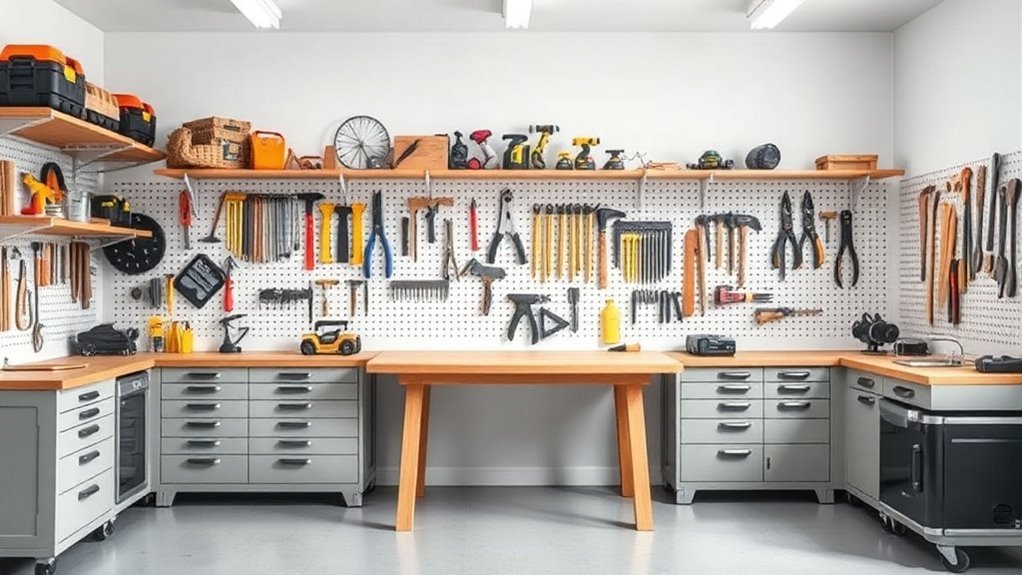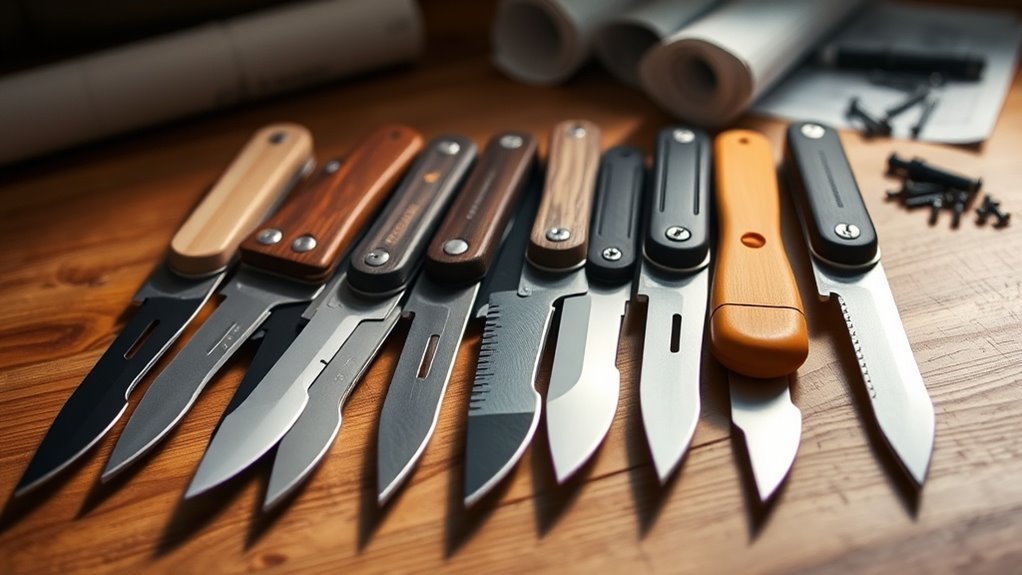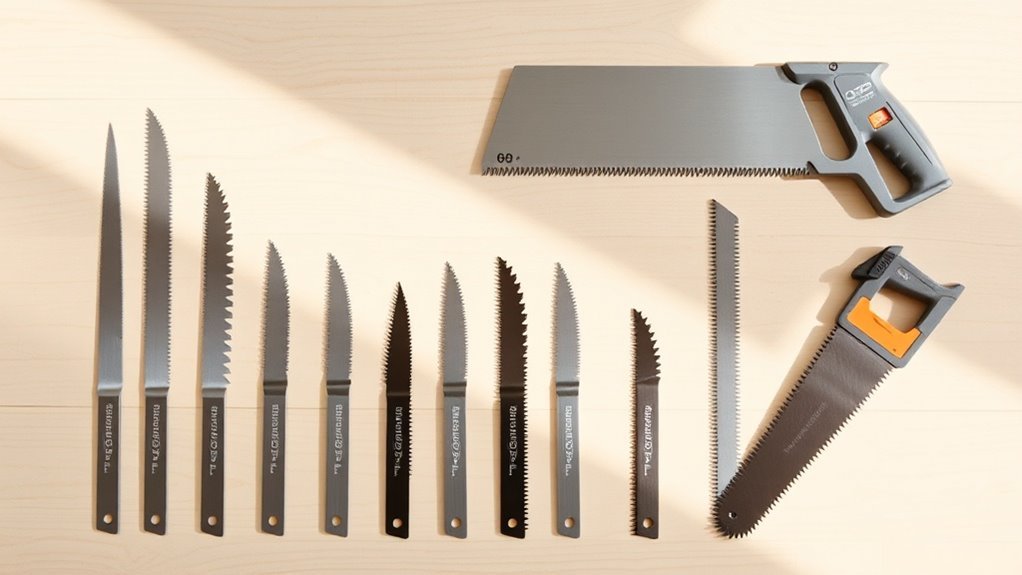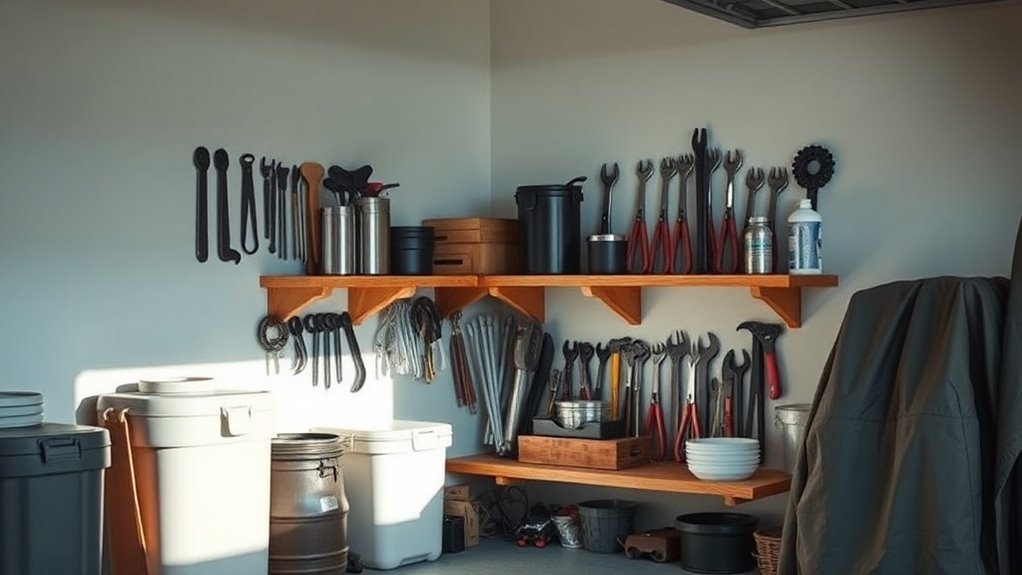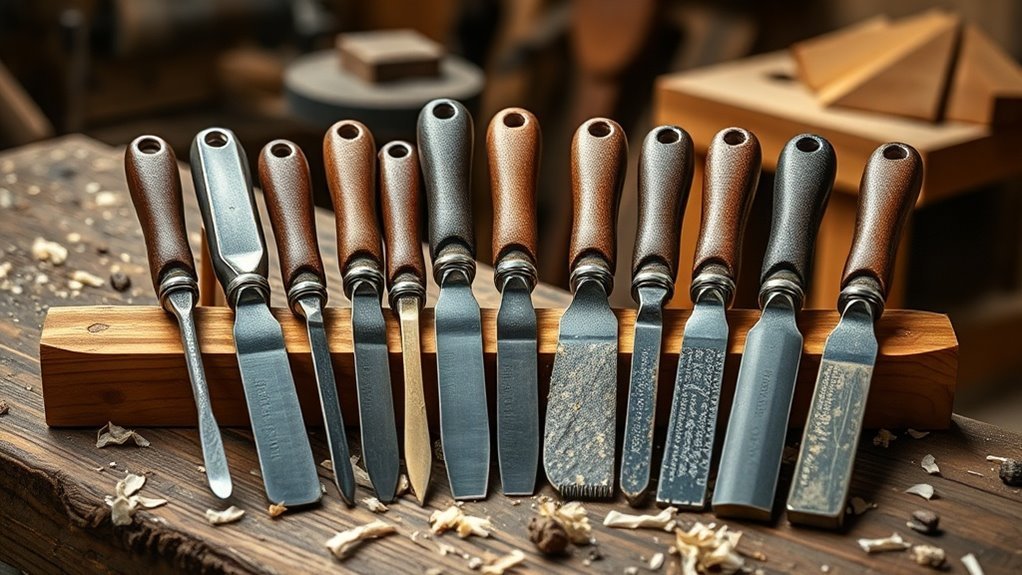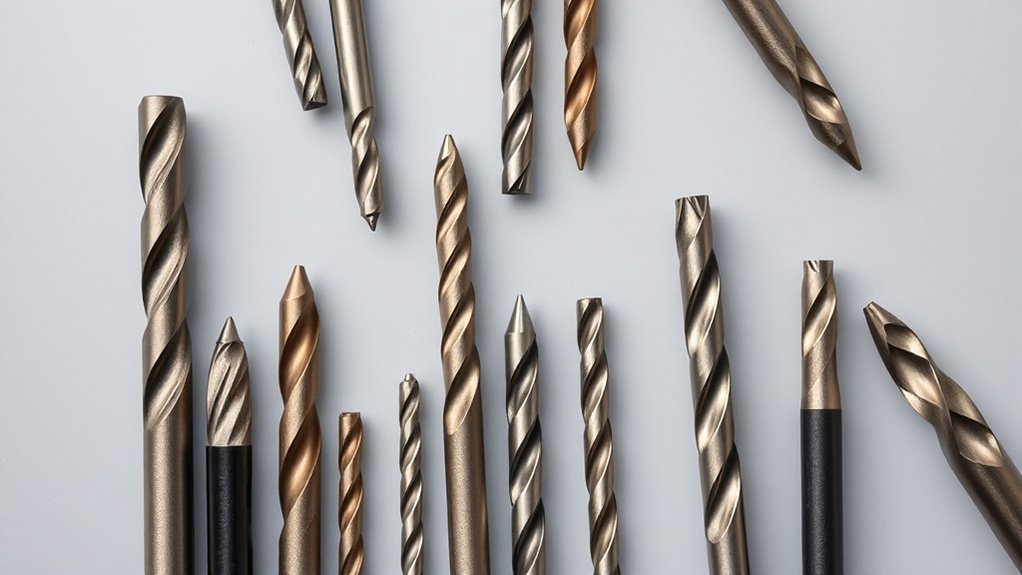Best Practices for Storing Sharp Tools Safely
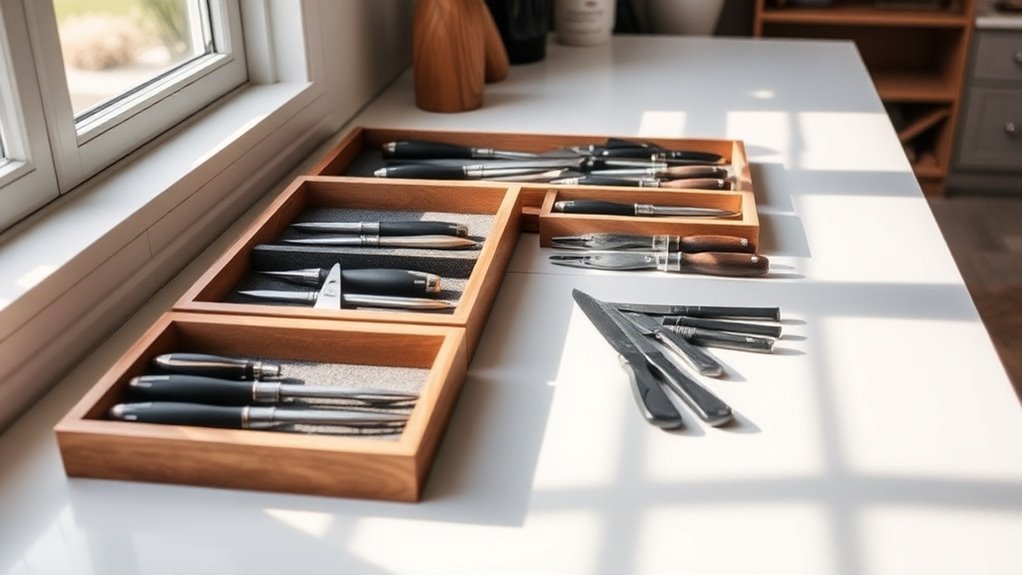
To store sharp tools safely, keep them out of reach of children, using high shelves or lockable containers. Always use blade guards or sheaths to prevent injuries and maintain sharpness. Organize your workspace by labeling and categorizing your tools, and make certain they’re dry and clean to avoid rust. Regularly inspect your tools for damage and keep learning about additional best practices for tool safety to enhance your overall tool management skills.
Key Takeaways
- Always store sharp tools in dedicated, labeled spaces to ensure quick identification and retrieval while enhancing safety.
- Use blade guards or sheaths to minimize the risk of injuries and maintain blade sharpness when storing sharp tools.
- Utilize high, inaccessible shelves or lockable cabinets to prevent unauthorized access, especially for children.
- Regularly inspect sharp tools for damage and dullness to maintain their functionality and safety before each use.
- Keep tools clean and well-lubricated to prevent rust and deterioration, ensuring they remain safe and effective over time.
Understand the Importance of Tool Storage
While it might seem easy to toss your sharp tools in a drawer or on a shelf, understanding the importance of proper tool storage is essential for safety and longevity.
When tools are improperly stored, they become difficult to access, increasing the risk of injury. You could accidentally cut yourself while searching for a specific tool, or tools could damage each other due to improper placement.
Additionally, keeping tools organized helps you stay efficient during projects, allowing you to find what you need without wasting time. Proper storage also protects your investment by preventing wear and tear, extending the life of your tools. Furthermore, storing tools in a dry, cool environment minimizes the risk of humidity-related damage, ensuring they remain functional for future projects.
Choose the Right Storage Container
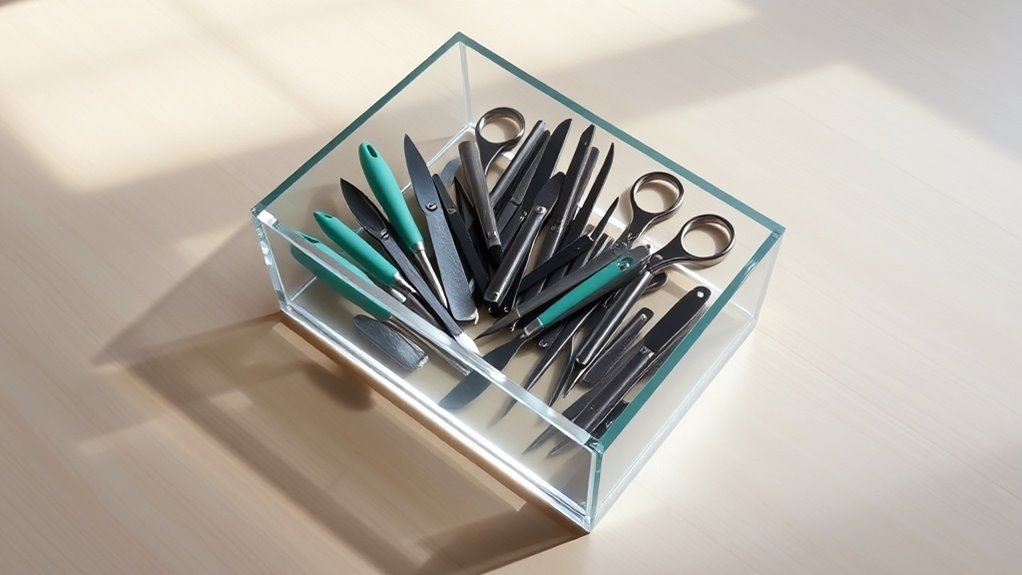
When it comes to storing sharp tools, picking the right storage container is essential.
You’ll want to take into account both the material and size to guarantee your tools stay protected and organized. A well-chosen container can prevent damage and make your workspace more efficient.
Material Selection Matters
Choosing the right storage container is essential for keeping your sharp tools safe and in good condition.
Materials play a key role in this. Opt for containers made from durable materials like metal or high-quality plastics that can withstand wear and minimize damage. Wooden boxes can also be effective, but make sure they’re treated to prevent moisture buildup that might lead to rot or rust.
Avoid flimsy materials, as they can break down over time and leave your tools vulnerable. For additional protection, consider containers lined with foam or rubber padding to cushion the tools.
This careful material selection will help you provide a stable environment for your sharp tools, extending their lifespan and guaranteeing safety whenever you reach for them.
Size and Space Considerations
After selecting the right materials for your tool storage, size and space become important factors. You’ll need to choose a storage container that fits your available space while accommodating your tools.
Consider the dimensions of your sharp tools; they’ll dictate the container’s size. Avoid containers that are too large, as they can lead to movement and potential accidents. Instead, opt for organizers with compartments that hold your tools securely.
If you’ve got limited vertical space, consider wall-mounted options or stackable bins. Always remember to leave some extra room for new tools in the future. This way, your setup remains tidy while ensuring safety and accessibility for your sharp tools.
Use Blade Guards and Sheaths
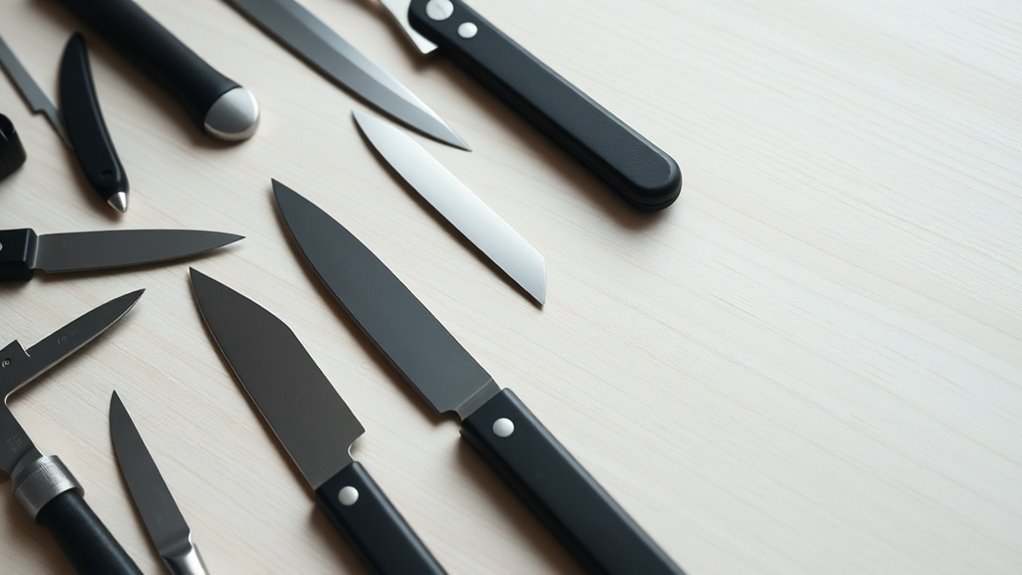
Using blade guards and sheaths is essential for protecting both your tools and yourself. When you take the time to invest in this simple safety measure, you’re not just preventing accidents; you’re also ensuring longevity for your sharp tools.
Here are three reasons to use them:
- Reduce Injury Risk: Sharp blades can cause severe injuries. A guard or sheath keeps you safe when reaching for tools.
- Maintain Sharpness: Protecting blades from damage helps maintain their sharpness, saving you time and effort on frequent resharpening.
- Enhance Storage: Properly sheathing your tools makes them easier to store, preventing unwanted accidents in crowded spaces.
Additionally, maintaining a clutter-free workspace is crucial when storing sharp tools, as it further minimizes the risk of injury. Don’t underestimate the importance of blade guards and sheaths in your safety and efficiency!
Organize Your Workspace
To keep your sharp tools accessible and safe, it’s essential to organize your workspace effectively.
Designate specific storage for each tool and make sure they’re clearly labeled and categorized. This way, you’ll always know where to find what you need, minimizing the risk of accidents and improving efficiency. Additionally, incorporating sturdy storage solutions can help prevent hazards associated with clutter while ensuring tools are stored safely and securely.
Use Designated Tool Storage
While it might seem tempting to leave tools scattered across your workspace, organizing them in designated storage areas is essential for both safety and efficiency.
When tools are properly stored, you not only reduce the risk of accidents but also improve your workflow.
Here are three benefits to using designated tool storage:
- Prevents Injuries: Keeping sharp tools out of reach minimizes the risk of cuts or accidents, especially in busy environments.
- Saves Time: Knowing exactly where each tool belongs allows you to quickly find what you need, making your projects more enjoyable.
- Promotes Responsibility: By having a place for everything, you’re more likely to treat your tools with care and respect.
Label and Categorize Tools
After establishing a designated storage area for your tools, the next step is to label and categorize them effectively.
Start by grouping similar tools together, like cutting, scraping, and shaping tools. This not only makes it easier to find what you need but also minimizes the risk of accidents. Use clear, visible labels that indicate the tool’s type or purpose.
You might consider color-coding for quick identification—red for sharp tools, blue for hand tools, for example. Make certain to regularly review and update your labels to guarantee they stay accurate as your collection changes.
Organized tools lead to a safer workspace, helping you avoid injuries and maintain efficiency during your projects.
Keep Tools Dry and Clean
Keeping your tools dry and clean is essential for maintaining their performance and longevity. When tools are neglected, they can become rusty or dull, which can lead to accidents or just plain frustration.
To help you keep your sharp tools in top shape, follow these key practices:
- Wipe Down After Use: Always clean your tools after each use. A quick wipe removes dirt, moisture, and oils that can cause deterioration.
- Store in a Dry Place: Make sure your storage area is dry and well-ventilated to prevent moisture buildup.
- Use Protective Lubricants: Applying a light coat of oil can shield blades from rust, keeping them sharp and ready for action. Additionally, consider using desiccants to control humidity levels in your storage space, as this further helps prevent rust formation.
Label and Categorize Tools
To guarantee you can quickly find the right tool when you need it, labeling and categorizing your sharp tools is essential.
Start by grouping tools based on their type and function, like knives, scissors, or chisels. This makes it easier for you to locate specific items. Use clear, durable labels that won’t wear off over time; consider labels with both names and images for quick identification.
Organize your tools by type and function, using clear, durable labels for easy and quick identification.
You might also organize tools by frequency of use—keeping the most used items at the front. Remember to regularly check your labels and categories to keep everything updated. A well-organized tool storage system not only saves you time but also helps maintain safety, ensuring you can grab the right tool without hassle. Additionally, implementing modular storage solutions can further enhance your tool organization and accessibility in the workspace.
Store Tools Out of Reach of Children
One of the most important safety measures when storing sharp tools is ensuring they’re kept out of reach of children.
You can never be too careful, as curiosity can lead to accidents.
Here are a few strategies to keep those little hands safe:
- High Storage: Place tools on high shelves or in cabinets that children can’t access.
- Lockable Storage: Invest in lockable toolboxes or cabinets to secure sharp instruments.
- Dedicated Space: Designate a tool area that’s off-limits to kids, reinforcing the importance of safety. Additionally, understanding the essential hand tools can help you effectively manage your toolbox while ensuring safe storage practices.
Regularly Inspect and Maintain Tools
Regular inspection and maintenance of your sharp tools can greatly enhance their performance and lifespan. Regularly checking for any damages or dullness can prevent accidents and guarantee you’re working with ideal equipment. Here’s a simple checklist to keep in mind:
| Tool Type | Key Inspection Points | Maintenance Tips |
|---|---|---|
| Knives | Check for nicks and dullness | Sharpen and oil regularly |
| Saws | Inspect teeth for damage | Clean and lubricate tracks |
| Scissors | Confirm blades align properly | Oil pivot points occasionally |
| Chisels | Examine for chips or cracks | Sharpen before use |
Staying proactive with inspections and maintenance not only keeps your tools in top shape but also contributes to your safety during use.
Train Others on Safe Tool Storage Practices
While it might seem straightforward, properly storing sharp tools is a skill that requires attention and practice, especially when teaching others.
You want to guarantee everyone understands not just the “how” but also the “why” behind safe storage practices. Here are three key points to emphasize:
- Risk of Injury: Remind them that improper storage can lead to accidents, which can have serious consequences.
- Longevity of Tools: Explain that careful storage prolongs the life of tools, saving money and time in the long run.
- Creating a Safe Environment: Stress the importance of a clutter-free workspace, which fosters productivity and safety.
Questions
How Can I Make DIY Blade Guards at Home?
You can make DIY blade guards using materials like wood, plastic, or cardboard. Cut them to size, ensuring they fully cover the blades. Attach them securely with duct tape or screws to keep your tools protected.
What Types of Storage Containers Are Best for Specific Tools?
Did you know over 30% of tool injuries happen at home? For specific tools, consider using drawer dividers for smaller items, pegboards for easy access, and heavy-duty boxes for larger equipment. It’s all about organization!
Is It Safe to Store Sharp Tools in a Toolbox?
Yes, it’s generally safe to store sharp tools in a toolbox, but make certain they’re organized and secured. Use protective inserts to prevent injury and keep the tools from damaging each other during transport or storage.
How Often Should I Inspect My Storage Methods?
You should inspect your storage methods regularly, like a gardener tending to their plants. Aim for at least once a month, ensuring everything’s in proper condition and ready for safe use whenever you need ’em.
Can I Use Magnetic Strips for Sharp Tool Storage?
Yes, you can use magnetic strips for sharp tool storage. They keep tools easily accessible and organized, but guarantee the strips are strong enough to hold the weight and won’t cause any accidents.
Conclusion
In the grand symphony of your workspace, storing sharp tools safely is the harmonious foundation that keeps everything in tune. By following these best practices, you’re not just protecting yourself but also ensuring a safe environment for others. Remember, a well-organized and secure tool setup is like a well-conducted orchestra, where every instrument is in its place, ready for action. So, take a moment to reinforce your storage methods and play your part in the safety melody!

